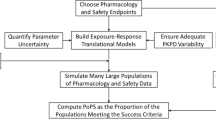Abstract
Currently, pharmaceutical companies are reluctant to introduce pharmacogenomics (PGx) in their practice, since cost–benefit of PGx is obscure and methodology to use PGx in drug development has not been fully established yet. The purpose of this study is to investigate advantages obtained by introducing PGx in clinical trials. Particularly, taking Warfarin as an example, we investigate benefits of Enrichment effect that raises response rate of the drug by PGx. When response rate is raised by only 5%, cost of a clinical trial can be reduced to about 40% of a conventional clinical trial. Furthermore, since period necessary for a trial also can be reduced, development period can be shortened by about 750 days. In summary, PGx enables earlier launch of a drug with less cost, representing benefit to pharmaceutical companies, patients and public as a whole.

Similar content being viewed by others
References
Evans, W. E., and Mcleod, H. L., Pharmacogenomics—Drug disposition, drug targets and side effects. N. Engl. J. Med. 348:538–549, 2003. doi:10.1056/NEJMra020526.
Weinshilboum, R., Inheritance and drug response. N. Engl. J. Med. 348:529–537, 2003. doi:10.1056/NEJMra020021.
Ernst, F. R., and Grizzle, A. J., Drug related morbidity and mortality: updating the cost-of-illness model. J. Am. Pharm. Assoc. 41:192–199, 2001.
Desta, Z., Zhao, X., Shin, J. G., et al., Clinical significance of the cytochrome P450 2C19 genetic polymorphism. Clin. Pharmacokinet. 41:913–958, 2002. doi:10.2165/00003088-200241120-00002.
Mushiroda, T., Ohnishi, Y., Saito, S., et al., Association of VKORC1 and CYP2C9 polymorphisms with warfarin dose requirements in Japanese patients. J. Hum. Genet. 51:249–253, 2006. doi:10.1007/s10038-005-0354-5.
Viroj, W., Pharmacogenetic effect of cytochrome P450 2C9 polymorphisms in different populations. Clin. Appl. Thromb. Hemost. 12 (2)219–222, 2006. doi:10.1177/107602960601200211.
Cardon, L. R., Idury, R. M., Harris, T. J., et al., Testing drug response in the presence of genetic information: sampling issues for clinical trials. Pharmacogenemics. 10:503–510, 2000. doi:10.1097/00008571-200008000-00003.
Fung, M., Thornton, A., Mybeck, K., et al., Evaluation of the characteristics of safety withdrawal of prescription drugs from worldwide pharmaceutical markets—1960 to 1999. Drug Inf. J. 35:293–317, 2001.
Huges, S., Huges, A., Brothers, C., et al., PREDICT-1(CNA106030). The first powered, prospective trial of pharmacogenetic screening to reduce drug adverse events. Pharm. Stat. 7:121–129, 2008. doi:10.1002/pst.286.
Sai, K., Sawada, J., Minami, H., et al., Irinotecan pharmacogenetics in Japanese cancer patients: Roles of UGTA1*6 and 28. Yakugaku. Zasshi. 128 (4)575–584, 2008. doi:10.1248/yakushi.128.575.
Garrison, L. P. Jr., Lubeck, D., Lalla, D., et al., Cost-effectiveness analysis of traszumab in the adjuvant setting for treatment of Her2-positive breast cancer. Cancer. 110:489–498, 2007. doi:10.1002/cncr.22806.
Brian, F., and Lawrence, J., Pharmacogenetics of warfarin; regulatory, scientific, and clinical issues. J. Thromb. Thrombolysis. 25:45–51, 2008. doi:10.1007/s11239-007-0104-y.
DeMets, D. L., Clinical trials in the new millennium. Stat. Med. 21:2779–2787, 2002. doi:10.1002/sim.1281.
McWilliam, A., Lutter, R., Nardinelli, C. et al., Health Care Savings from personalizing Medicine Using Genetic testing. AEI Bookings Joint Center for Regulatory Studies, Working Paper 6-23, 2006.
Ministry of Education, Culture, Sports, Science and Technology, Leading Project. Biobank Japan. http://www.biobankjp.org/info/IC0802.pdf. 2005.
Veenstra, D. L., Higashi, M. K., and Phillips, K. A., Assessing the cost-effectiveness of pharmacogenomics. AAPS. PharmSci. 29 (3)1–11, 2000.
Japan Pharmaceutical Manufacturers Association, Questionnaire about pharmacogenomics. https://www1.meteo-intergate.com/news/letter/119/, 2007
Hurlen, M., Abdelnoor, M., Smith, P., et al., Warfarin, aspirin, or both after myocardial infarction. N. Engl. J. Med. 347 (13)969–974, 2002. doi:10.1056/NEJMoa020496.
Gallen, C., Clinical research and development. Wyeth Pharmaceuticals, Collegeville, p. 19426, 2006.
Japan Pharmaceutical Manufacturers Association, Proposal for extension of patent period, February, 2009 http://www.jpo.go.jp/shiryou/toushin/shingikai/pdf/entyou-wg03_shiryou/entyou-wg_shiryou03.pdf.
Shah, R. R., Regulatory aspects of pharmacogenetics and pharmacogenomics. Bundesgesundheitsblatt. Gesundheitsforschung. Gesundheitsschutz. 46:855–867, 2003. doi:10.1007/s00103-003-0697-z.
Yatsuda Y., Sales rank of world medicines, Utobain News release, Jul 2007. http://www.utobrain.co.jp /news-release/2007/070700/NewsRelease0707.pdf
The calculation is based on the data in “Commission to facilitate marketing of effective and safe medicine”, MHLW, October 30, 2006. http://www.mhlw.go.jp/shingi/2007/07/dl/s0730-10a.pdf
Saito, H., Current Status and Issues of Drug Development Strategy in Japan. Drug Deliv. Syst. 1, 65–72, 2002.
Genelex. Pharmacogenetics: personalizing medicine today. In Health and DNA. Seattle, Washington U.S. 2007. http://www.healthanddna.com/professional/pharmacogenetics.html#2c9
Ernst, F. R., and Grizzle, A. J., Drug-related morbidity and mortality: updating the cost-of-illness model. J. Am. Pharm. Assoc. 41:192–199, 2001.
Bureau of Labor Statistics, Consumer price index for medical care, 2002–2006.
Rieder, M. J., Effect of VKORC1 haplotypes on transcriptional regulation and warfarin dose. N. Engl. J. Med. 352 (22)2285–2293, 2005. doi:10.1056/NEJMoa044503.
Genetic Information Nondiscrimination Act:GINA. http://www.house.gov/apps/list/speech/edlabor_dem/rel050108.html
SNP Genotyping and Analysis Markets. Kalorama Information, 2008. http://www.infoshop-japan.com/publisher/KL.shtml
Cabinet Office, Government of Japan, Act on the Protection of Personal Information, May, 2003, http://www5.cao.go.jp/seikatsu/kojin/houritsu/index.html
Ministry of Health, Labour and Welfare, Ethical Guidelines for Human Genome and Genetic Sequencing Research, December, 2004, http://www5.cao.go.jp/seikatsu/shingikai/kojin/20050127kojin-sanko2-3.pdf
Author information
Authors and Affiliations
Corresponding author
Rights and permissions
About this article
Cite this article
Ohashi, W., Tanaka, H. Benefits of Pharmacogenomics in Drug Development—Earlier Launch of Drugs and Less Adverse Events. J Med Syst 34, 701–707 (2010). https://doi.org/10.1007/s10916-009-9284-7
Received:
Accepted:
Published:
Issue Date:
DOI: https://doi.org/10.1007/s10916-009-9284-7




